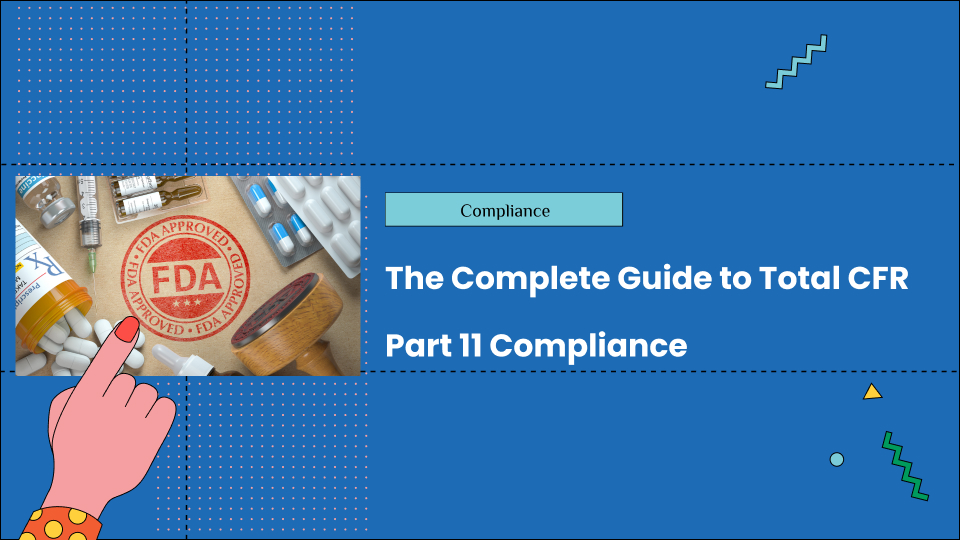Disclaimer: While GoVisually strives to convey accurate information, please refer to the official document offered by the government for the most up-to-date guidelines on food and safety and labeling.
Heard of CFR Part 11 recently released by FDA, but don’t want to get into too technical terms? We got you! We understand that the information at government sources are presented in a more complicated and technical manner. That’s why GoVisually has come up with this easy-to-comprehend CFR Part 11 guide. We have divided the information into a digestible section that covers precise information.
Now, who should read this guide?
This guide is extremely useful for anyone who is looking to understand the latest changes in CFR Part 11 regulations and code of conducts. In this guide, we have explained everything related to CFR Part 11. We cover every relevant and necessary aspect of the regulation, starting with its basic definition to the latest requirements for life science organizations and device manufacturers.
Read on to learn the easiest breakdown of CFR Part 11 compliance regulations.
Table of Contents
What is 21 CFR Part 11?
21 CFR Part 11 is a FDA established regulation that outlines for electronic records, and electronic signatures. These regulations are mandated to follow to prove that the digital records and signatures are accurate, reliable and equivalent to traditional paper records and handwritten signatures.
The first 21 CFR Part 11 regulation was established in March 1997. Later, it led to a lot of confusion among medical device makers and other industries due to lack of clarifications in the requirement. That’s why FDA published a guidance document clarifying the scope and implications of these requirements among various industries.
The guidance document was published to help teams from quality assurance departments, RnD, product management etc. Using this document, these departments can understand FDA requirements related to e-records and r-signature, such as software validation, audit trail, managing legacy systems, keeping copies of records and record retention.
Who needs to comply with CFR Part 11?
The CFR Part 11 regulation applies to all the departments regulated by FDA. This includes;
- Food and Beverage
- Pharmaceuticals
- Dietary Supplements
- Cosmetics
- Clinical Laboratories
- Biotechnology companies
- Contract Research Organization (CROs)
- Contract Manufacturing Organization (CMOs)
- Healthcare and healthcare marketing
- Medical devices manufacturing industry
What are the requirements of FDA CFR Part 11?
Here, we have divided the requirements of Part 11 based on the structure of regulation itself. The regulation is divided into several sections, and each section addresses specific requirements. Learn below about each section thoroughly.
1. General Provisions (Sections 11.2 – 11.3)
This section covers the scope of CFR along with when and how the IT should be implemented. It also defines some of the key terms used throughout the regulations.
Section 11.1, Scope of CFR Part 11
According to Section 11.1, the scope of CFR Part 11 will include the following.
- The scope of Part 11 intends to avoid unnecessary controls, costs and discourage innovation.
- Part 11 would not generally apply for paper printouts of electronic records.
- The scope of CFR Part 11 applies to electronics that are created, modified, maintained, archived, retrieved, or transmitted electronic records.
- CFR Part 11 focuses on electronic versions of records you are already required to maintain by other FDA regulations. These could be documents related to product development, testing, or manufacturing.
- Whether or not a specific record type is mentioned in another FDA regulation, if it is an electronic record, CFR Part 11 applies.
- Electronic records submitted to the FDA in accordance with the Federal Food, Drug, and Cosmetic Act or the Public Health Service Act are also subject to CFR Part 11.
Section 11.2, Implementation of CFR Part 11:
- According to section 11.2, medical devices companies can use paperless record-keeping systems, if they comply with FDA regulations.
- The FDA will also accept electronic records from medical device firms provided they comply with CFR Part 11 and the specific record type is listed in docket No. 92S-0251 as an acceptable electronic submission format.
Section 11.3, Definitions
FDA provides definitions of terms that will be used throughout the regulations.
- Act: The Food, Drug, and Cosmetic Act is referred to here.
- Agency: The Food and Drug Administration is referred to here.
- Biometrics: Biometrics is the term for a technique used to assess a person’s distinct physical characteristic (like a fingerprint) or repeated behavior (like typing style) in order to confirm that person’s identity.
- Closed System: A computer system where the individuals in charge of its contents also regulate user access.
- Electronic Record: Digital data created or utilized by a computer system is referred to as an electronic record.
- Digital Signature: It is an electronic signature that has a mechanism to confirm the signer’s identity, the authenticity of the signature, and the consistency of the document they signed.
- Electronic Signature: A collection of characters that are as distinct and
2. Electronic Records (Sections 11.10 – 11.20):
Under Section 11.10-11.20, you will learn about the requirements for administration of closed and open electronic record keeping systems. Further, it will simplify the signature manifestations and requirements for establishing a link between signatures and records.
Here is the tabular breakdown of each regulation along with the actional tips to understand how you can implement it in your industry.
| REGULATIONS | ACTIONABLE TIP |
| Ensure Authenticity, Integrity, and Confidentiality (if applicable) of E-Records (Section 11.10) |
|
| Validate Computer Systems (Section 11.10) | Regularly test your computer systems to ensure they function as intended and meet all regulatory requirements. This validation should ensure the accuracy, reliability, and consistency of your electronic records. |
| Generate Accurate and Complete Copies of E-Records (Section 11.10) | Develop a system for generating complete and accurate copies of your e-records in a human-readable format, such as a PDF or printout. This is important for inspections, reviews, and potential legal needs. |
| Protect Records for Easy Retrieval (Section 11.10) | Implement a system to safeguard your e-records and ensure they can be retrieved throughout their required retention period. This can involve data backups and archiving strategies. |
| Limit System Access to Authorized Individuals (Section 11.10) | Establish a system to restrict access to e-records based on user roles and permissions. Only authorized personnel should be able to view, modify, or delete sensitive electronic records. |
| Use Secure Audit Trails (Section 11.10) | Implement audit trails that capture all actions taken on e-records. This information should include the user who performed the action, the date and time, and the specific details of the action taken (e.g., what was changed in the record). Importantly, these audit trails should be secure and tamper-evident to prevent unauthorized alteration. |
| Maintain Procedures for Electronic Records (Section 11.15) | * Document clear procedures for handling e-records throughout their lifecycle (creation, modification, storage, retrieval, deletion, archiving). |
| Identify Record Ownership (Section 11.30) | * Establish a system for identifying the owner (creator) of each electronic record. This ensures accountability and helps track any changes made to the record. |
| Retain Records According to Regulations (Section 11.10) | * Determine the required retention period for your electronic records based on relevant FDA regulations or company policies. Ensure your system can store e-records for the mandated time frame. |
| Use Digital Signatures When Appropriate (Section 11.10) | * Consider implementing electronic signatures to authenticate individuals who approve or certify critical electronic records. |
3. Electronic Signatures (Sections 11.50 – 11.70):
Under these sections, we will split the requirements into three sub-categories; general requirements for electronic signatures, electronic signature components and controls, and controls for identification codes/passwords. Learn the requirements through the below table.
| REGULATIONS | ACTIONABLE TIP |
| Signatures Must Be Unique to Each User (Section 11.10) | * Implement an electronic signature system that assigns unique identifiers to each user. This could involve digital certificates or other secure mechanisms. |
| Link Signatures to Reliable User Identification (Section 11.10) | * Ensure your electronic signature system is linked to a reliable method of user identification. This could involve usernames, passwords, or two-factor authentication. |
| Prevent Unauthorized Signature Use (Section 11.10) | * Implement security measures to prevent unauthorized use of electronic signatures. This could involve strong passwords, multi-factor authentication, and user activity monitoring. |
| Capture Signature Information (Section 11.10) | * Configure your system to capture relevant information alongside the electronic signature. This might include the date and time of signing, the identity of the signer, and the specific record being signed. |
| Maintain Signature Controls (Section 11.30) | * Establish and document procedures for managing electronic signatures. This may involve assigning signature privileges, monitoring signature use, and handling potential misuse. |
| Restrict Signature Modification (Section 11.10) | * Configure your electronic signature system to prevent the modification of signed records after the signature is applied. |
| Maintain Signature History (Section 11.10) | * Ensure your system maintains a record of all electronic signature events, including who signed what record and when. This information should be part of the audit trail. |
| Use Time-Stamping (Section 11.10) | * Implement time-stamping functionality to capture the precise date and time an electronic signature is applied. This ensures a clear record of the signing event. |
How to implement 21 CFR Part 11?
Implementing compliance with 21 CFR Part 11 requires the following crucial steps:
- Gap Analysis: Examining existing processes and systems for compliance gaps.
- Risk assessment: Determining how the found gaps might affect regulatory compliance and data integrity.
- Remediation strategy: Creating a thorough strategy with deadlines, roles, and resource allocation to close identified holes.
- Training and Awareness: Making certain that all pertinent staff members receive training on 21 CFR Part 11 regulations and are aware of their responsibilities for upholding compliance.
- Continuous Monitoring and Improvement: Putting in place a process for continuous improvement to handle new issues and regulatory changes, as well as continuous monitoring methods to identify compliance drift.
Conclusion
If you found this blog helpful, checkout our latest editions guides and blogs related to labelling and packaging industry. All the blogs are verified by experts, but we would still emphasis the importance of authentic information from the official website of FDA to get real-time data.





